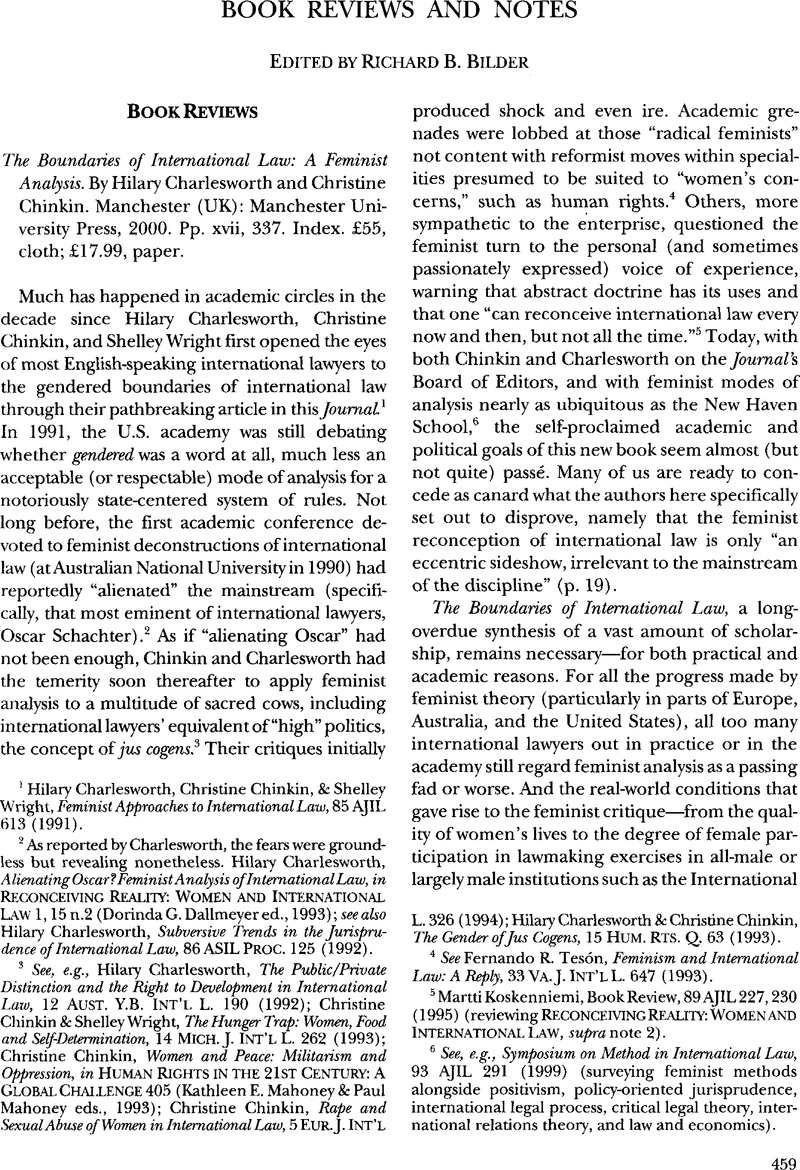Published online by Cambridge University Press: 27 February 2017

1 Charlesworth, Hilary, Chinkin, Christine, & Wright, Shelley, Feminist Approaches to International Law, 85 AJIL 613 (1991).CrossRefGoogle Scholar
2 As reported by Charlesworth, the fears were groundless but revealing nonetheless. Charlesworth, Hilary, Alienating Oscar’? Feminist Analysis of International Law, in Reconceiving Reality: Women and International Law 1, 15 n. 2 (Dorinda, G. Dallmeyered., 1993)Google Scholar; see also Charlesworth, Hilary, Subversive Trends in the Jurisprudence of International Law, 86 ASIL Proc. 125 (1992).Google Scholar
3 See, e.g., Charlesworth, Hilary, The Public/Private Distinction and the Right to Development in International Law, 12 Aust. Y.B. Int’l L. 190 (1992)Google Scholar; Chinkin, Christine & Wright, Shelley, The Hunger Trap: Women, Food and Self-Determination, 14 Mich. J. Int’l L. 262 (1993)Google Scholar; Chinkin, Christine, Women and Peace: Militarism and Oppression, in Human Rights in the 21st Century: A Global Challenge 405 (Kathleen, E. Mahoney & Mahoney, Paul eds., 1993)Google Scholar; Chinkin, Christine, Rape and Sexual Abuse of Women in International Law, 5 Eur. J. Int’l L. 326 (1994)CrossRefGoogle Scholar; Charlesworth, Hilary & Chinkin, Christine, The Gender of Jus Cogens, 15 Hum. Rts. Q. 63 (1993).CrossRefGoogle Scholar
4 See Fernando, R. Teson, Feminism and International Law: A Reply, 33 Va. J. Int’l L. 647 (1993).Google Scholar
5 Koskennierai, Martti, Book Review, 89 AJIL 227, 230 (1995)Google Scholar (reviewing Reconceiving Reality: Women and International Law, supra note 2).
6 See, e.g., Symposium on Method in International Law, 93 AJIL 291 (1999)Google Scholar (surveying feminist methods alongside positivism, policy-oriented jurisprudence, international legal process, critical legal theory, international relations theory, and law and economics).
7 See, e.g., Reconceiving Reality: Women and International Law, supra note 2; Human Rights of Women ational and International Perspectives (Cook, Rebecca ed., 1994)Google Scholar; Women and International Human Rights Law (Kelly, D. Askin & Koenig, Dorean eds., 1999-2001).Google Scholar
8 See Knop, Karen, Re/statements: Feminism and State Sovereignty in International Law, 3 Transnat’l L. & Contemp. Probs. 293, 306 (1993).Google Scholar
9 Convention on the Rights and Duties of States, Dec. 26, 1933, 165 LNTS 19, reprinted in 28 AJIL Supp. 75 (1934).
10 The authors’ contention that territorial integrity, for example, is a gendered notion and that it would be better to have more permeable borders is likely to elicit a predictable response in defense of the Charter order, as well as from those who believe that sovereignty continues to have its “progressive” uses. See, e.g., Kingsbury, Benedict, Sovereignty and Inequality, 9 Eur. J. Int’l L. 599 (1998).CrossRefGoogle Scholar
11 Thus, the authors challenge comfortable notions of self-determination that fail to consider the adverse consequences of independence on women, and they explore the inequities of certain doctrines such as restrictive immunity, which limits sovereign immunity for the sake of protecting the interests of commercial enterprises, while leaving that immunity intact with respect to significant concerns of women.
12 See Tesón, supra note 4; Anthony, D’Amato, Book Review, 89 AJIL 840 (1995)Google Scholar (reviewing Human Rights of Women: National and International Perspectives, supra note 7); Koskenniemi, supra note 5. The authors’ response to charges of lack of objectivity is much like those made in response to those who would ban certain forms of “harmful” speech. See, for example, Justice Vinson’s plurality opinion in Dennis v. United States, 341 U.S. 494 (1951) (noting that the basis of the First Amendment is the hypothesis that harmful speech is best countered by more speech). Like Justice Vinson, Charlesworth and Chinkin’s answer to international law’s gendered and sexed subjectivity is not less but more subjectivity: since international law does not provide even a “partial, consensual, formal distance” from subjectivity, we should not be troubled by an approach that acknowledges that law has a political agenda (p. 22).
13 Cf. Kennedy, David, My Talk at the ASIL: What Is New Thinking in International Law? 94 ASIL Proc. 104 (2000).Google Scholar
14 The authors’ conception of “world travelling,” borrowed from a number of authors, requires scholars to acknowledge the particularities of their own, as well as others’, historical and cultural context (p. 51).
15 Cf. Anne-Marie, Slaughter, International Law in a World of Liberal States, 6 Eur. J. Int’l L. 503 (1995)Google Scholar; Fernando, TesÓn, A Philosophy of International Law (1998)Google Scholar. For an introduction to liberal theory, see Moravscik, Andrew, Taking Preferences Seriously: A Liberal Theory of International Politics, 51 Int’l Org. 513 (1997).CrossRefGoogle Scholar
16 P. 248 (quoting Otto, Dianne, A Post-Beijing Reflection on the Limitations and Potential of Human Rights Discourse for Women, in 1 Women and International Human Rights Law 115, 127 (Kelly, D. Askin & Dorean, M. Koenig eds., 1999)Google Scholar).
17 The impact of feminist critiques on Third World scholarship appears to be considerable. See, as one example, Murray, Rachel, The African Commission on Human and People’s Rights and International Law (2000)Google Scholar (an analysis of African human rights—by an insider to those processes—that is self-consciously modeled on feminist critiques and dichotomies).
18 717 F.2d 610 (D.C. Cir. 1983).
19 Cf. Commitment and Compliance: the Role of Non-Binding Norms in the International Legal System (Shelton, Dinah ed., 2000)Google Scholar; Douglas, M. Johnston, Book Review, 95 AJIL (forthcoming 2001)Google Scholar (reviewing id.).
20 Chinkin and Charlesworth argue that the concept of equity “has been primarily restricted to boundary demarcation and individual instances of resource allocation between states” but has not been used to redress structural injustices either between persons within a state or between states (p. 80).